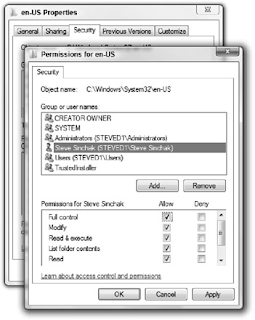
The alternative boot screen that you just enabled in the preceding section is a great improvement compared to the boring moving progress bar that shows by default. However, this is still not good enough. With the help of a few cool tricks, you can create your own high-resolution, 24-bit boot screen without hacking any system files.
How is that possible? Thanks to the new language-independent operating system components in Windows Vista, some resources are stored in regional language files rather than the actual system components. This allows Microsoft to easily create a localized version of Windows Vista in any language by just creating new MUI (multilingual user interface) files that contain localized versions of bitmaps and text. Because MUI files are not digitally signed by Microsoft, you can make your own that has your own boot screen image in it, which allows you to customize the alternative boot screen to use any image you desire.
This new feature in Windows Vista provides a great
enhancement and alternative to the traditional method of hacking system files as you had to do in previous versions of Windows to do things such as changing the boot screen. In addition, there is a great tool developed by Dan Smith called the Vista Boot Logo Generator that will automatically compile the boot images you select into an MUI file. This makes the overall process simple compared to trying to change boot screens, as you did in the past.
enhancement and alternative to the traditional method of hacking system files as you had to do in previous versions of Windows to do things such as changing the boot screen. In addition, there is a great tool developed by Dan Smith called the Vista Boot Logo Generator that will automatically compile the boot images you select into an MUI file. This makes the overall process simple compared to trying to change boot screens, as you did in the past.
To get started, you need two images, one 800 × 600 and one 1024 × 768 image, both saved as 24-bit bitmap images. When you have those images picked out, resized, and saved, you are ready to follow these steps:
- Visit http://www.computa.co.uk/staff/dan/?p=18 and download the latest copy of the Vista Boot Logo Generator and install it.
- Click the Start button, type vista boot logo, and press Enter.
- After the boot logo is downloaded, click the Browse for Images button in the 800 × 600 section and select your 800 × 600 24-bit bitmap image. Do the same for the 1024 × 768 section.
- After you have both images selected, click File and select Save Boot Screen file as to save your MUI file. Save it to your desktop.
- Next you need to replace the winload.exe.mui file located in c:\windows\system32\en-us with the file you just created. However, it is not as easy as a simple copy and paste because the Windows system files are protected. First, I recommend making a backup of the existing winload.exe.mui file so that you can copy it back if you have problems later. To get around the file protections, you need to take ownership of all the files in the en-us folder. Right-click the en-us folder and select Properties.
- Select the Security tab and then click the Advanced button at the bottom of the window.
- Select the Owner tab, and then click the Edit button.
- Select your account from the Account list and check Replace owner on subcontainers and objects. Click OK to apply your changes.
- Click OK to exit all the open Properties windows. You need to go back into the folder properties to change the file permissions. This time you will have more rights because you are now the folder owner. Right-click en-us and select Properties again.
- Click the Security tab, and this time click Edit.
- Click the Add button. Type in your username and click OK. Your account name should now appear on the Permissions list.
- Select your account, and then select the Allow column for Full control, as shown in Figure 1-3.
Figure 1-3: Giving your account full control over the en-us MUI files to change the boot screen - Click OK to save your changes and OK once more to close the Properties screen. You will now be able to copy the winload.exe.mui file you made and saved to your desktop to c:\windows\system32\en-us. After you copy the file and reboot, you should see your new boot screen.
If you do not see your new boot screen and instead see the progress bar, make sure that you turned on the alternative boot screen as shown in the previous section. If you have any problems with your new boot screen MUI file, you can always boot using your Windows Vista install CD into a command prompt and can copy back the old winload.exe.mui file.





















